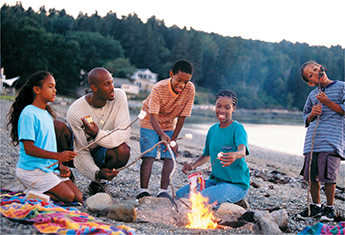Mechanical energy does not include thermal energy, chemical energy, or other forms of energy associated with the motion or the arrangement of atoms or molecules. Most of these other forms of energy do involve kinetic or potential energy, but on an atomic scale. However, the mechanical energy of a speeding train and a sprinting athlete comes from the chemical energy of the train's fuel and the sprinter's body cells.
Thermal Energy
Almost all of the matter around you contains atoms. These particles are always in random motion and thus have kinetic energy. The total potential and kinetic energy related to the motion of all the microscopic particles in an object make up its thermal energy. When an object's atoms move faster, its thermal energy increases and the object becomes warmer. As Figure 6 shows, when objects are hot enough, they can emit visible light.
Chemical Energy
The campers in Figure 7 are toasting marshmallows over a campfire. The source of energy for the fire is the energy stored in wood. When the wood is burned, energy is released and heats the marshmallows as well as the area around the campfire. The energy stored in wood is chemical energy. Chemical energy is the energy stored in chemical bonds. When bonds are broken, the released energy can do work. All chemical compounds, including fuels such as coal and gasoline, store energy. For example, cars can use the chemical energy stored in gasoline to move about. The gasoline is burned in the car's engine and some of its chemical energy is converted into mechanical energy to move the car.

What is chemical energy?
Figure 6 Energy occurs in many forms. This molten metal is extremely hot. It contains a great deal of thermal energy. Observing What other kinds of energy are evident in this photograph?

Figure 7 This family is using the chemical energy of burning wood to produce thermal energy for heating marshmallows.





